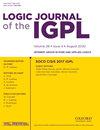The higher dimensional propositional calculus
IF 0.8
4区 数学
Q2 LOGIC
引用次数: 0
Abstract
In recent research, some of the present authors introduced the concept of an $n$-dimensional Boolean algebra and its corresponding propositional logic $n\textrm{CL}$, generalizing the Boolean propositional calculus to $n\geq 2$ perfectly symmetric truth values. This paper presents a sound and complete sequent calculus for $n\textrm{CL}$, named $n\textrm{LK}$. We provide two proofs of completeness: one syntactic and one semantic. The former implies as a corollary that $n\textrm{LK}$ enjoys the cut admissibility property. The latter relies on the generalization to the $n$-ary case of the classical proof based on the Lindenbaum algebra of formulas and Boolean ultrafilters.高维命题微积分
在最近的研究中,一些作者引入了$n$维布尔代数及其相应的命题逻辑$n\textrm{CL}$的概念,将布尔命题微积分推广到了$n\geq 2$完全对称真值。本文为 $n\textrm{CL}$ 提出了一个完善而完整的序列微积分,命名为 $n\textrm{LK}$。我们提供了两个完备性证明:一个是语法证明,另一个是语义证明。前者的推论是 $n\textrm{LK}$ 具有切分可接受性。后者依赖于基于林登鲍姆公式代数和布尔超滤波器的经典证明在 $n$-ary 情况下的推广。
本文章由计算机程序翻译,如有差异,请以英文原文为准。
求助全文
约1分钟内获得全文
求助全文
来源期刊
CiteScore
2.60
自引率
10.00%
发文量
76
审稿时长
6-12 weeks
期刊介绍:
Logic Journal of the IGPL publishes papers in all areas of pure and applied logic, including pure logical systems, proof theory, model theory, recursion theory, type theory, nonclassical logics, nonmonotonic logic, numerical and uncertainty reasoning, logic and AI, foundations of logic programming, logic and computation, logic and language, and logic engineering.
Logic Journal of the IGPL is published under licence from Professor Dov Gabbay as owner of the journal.

 求助内容:
求助内容: 应助结果提醒方式:
应助结果提醒方式:


